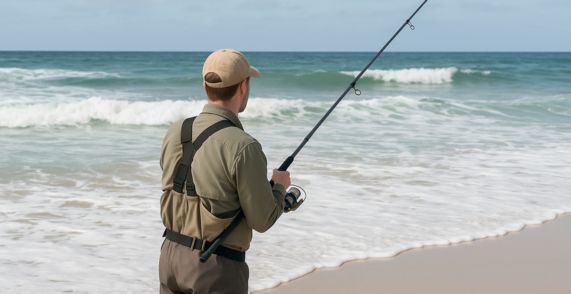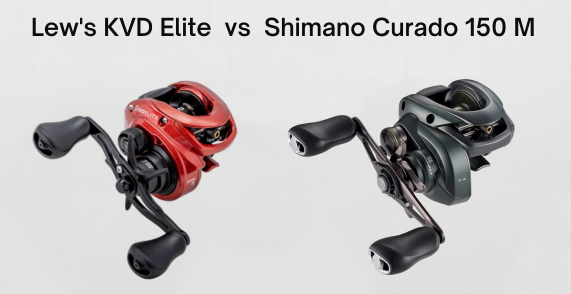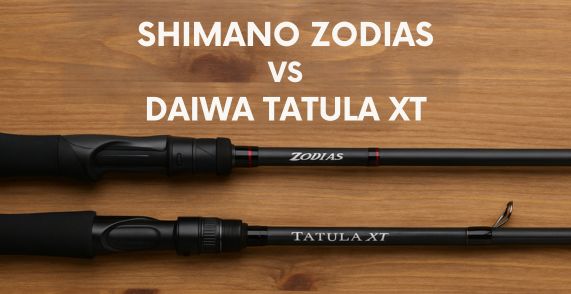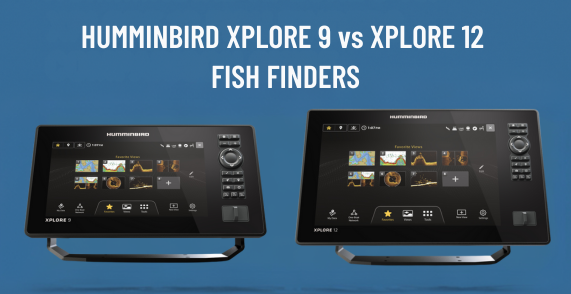In This Post
- 1 Key Takeaways:
- 2 Why Most Beginners Struggle with Surf Fishing Success
- 3 Reading the Beach: Location Errors That Cost You Fish
- 4 Gear Gaffes: Equipment Mistakes That Limit Success
- 5 Technique Troubles: Casting and Retrieving Errors
- 6 Bait Blunders: Why Your Offerings Get Rejected
- 7 Safety Oversights That Can Ruin Your Day
- 8 Turn These Mistakes Into Advantages on Your Next Trip
Key Takeaways:
- Fishing in dirty or murky water dramatically reduces your chances of success as many surf species are sight feeders
- Beach structure like cuts, troughs, and rip currents are natural fish magnets that should be targeted rather than random spots
- The belief that you must cast as far as possible is a myth – fish are often feeding much closer to shore than beginners expect
- Fishing with the proper gear is essential – use 7-9 foot medium-heavy rods for smaller species and 12-15 foot heavy rods for larger targets
Why Most Beginners Struggle with Surf Fishing Success
Standing at the edge of the vast ocean with rod in hand, many beginners feel intimidated by surf fishing’s apparent complexity. The good news? Most of your frustrations likely stem from a few common mistakes that are easily corrected. As the experts at Fishing Zenith regularly point out, understanding these errors can dramatically improve your success rate almost immediately.
The surf zone constantly changes and requires specific approaches different from other fishing styles. Many anglers struggle because they’re applying techniques that work in lakes or piers but aren’t suited for the unique challenges of the beach. Let’s examine the most common mistakes and how to fix them.
Reading the Beach: Location Errors That Cost You Fish
Fishing Dirty or Murky Water When Fish Can’t See Your Bait
One of the most damaging errors beginners make is fishing in dirty, murky water. Unlike some freshwater species that thrive in turbid conditions, many surf species like pompano, whiting, and flounder are primarily sight feeders. They need to see your bait to eat it.
When the water has that chocolate milk appearance or contains excessive floating debris, your chances of success plummet dramatically. This is especially true during or after storms when churning waves stir up sand and sediment. Instead of hoping for the best in these conditions, consider:
- Driving to a different beach where water clarity might be better
- Waiting until tides and winds have had time to clear the water
- Fishing the cleaner water behind sandbars where visibility may be better
Missing Key Structure: Cuts, Troughs, and Rips That Hold Fish
The beach isn’t a uniform environment – it contains complex underwater topography that concentrates fish in specific areas. Beginners often make the critical mistake of setting up at random spots based on parking convenience rather than reading the beach for productive structure.
Look for these fish-holding features:
- Cuts and troughs: Deeper channels running parallel to the beach, often identifiable by darker colored water
- Rip currents: Areas where water flows back out to sea, carrying food and creating feeding zones
- Points and sandbars: These create current breaks where predators ambush baitfish
- Depressions and holes: Deeper pockets that provide shelter and feeding opportunities
The difference between fishing these structure spots versus random beach access points can be the difference between catching multiple fish and going home empty-handed.
Ignoring Tide Movement: Why Timing Trumps Location
Many new surf anglers plan their fishing around convenient times of day rather than optimal tide conditions. This fundamental mistake undermines even the best equipment and techniques.
Fish in the surf zone are significantly more active during moving water – either incoming or outgoing tides. These tidal movements create currents that distribute bait, expose feeding areas, and trigger predatory fish to feed actively. Conversely, fishing during slack tide (the period between tide changes when water movement is minimal) often results in slow action even in otherwise productive locations.
For optimal results:
- Schedule fishing trips during rising or falling tides rather than at peak high or low tide
- The last 1-2 hours of an incoming tide often produces the best big fish activity
- Use tide charts or fishing apps to plan outings around these prime movement periods
Staying Put When Nothing’s Biting
Persistence is a virtue in fishing, but stubbornness is not. A common beginner mistake is camping at one spot for hours despite receiving no bites. Fish in the surf zone are constantly moving, following bait and reacting to changing conditions.
If you’ve been fishing a location for 15-30 minutes without any action (no bites, no visible fish activity), it’s usually more productive to move rather than wait it out. This is especially true when using smaller baits like sand fleas or pieces of shrimp – if these aren’t being touched, fish likely aren’t present in that area.
Gear Gaffes: Equipment Mistakes That Limit Success
Rod and Reel Mismatches: Choosing the Wrong Tools for the Job
I’ve watched countless beginners show up to the beach with inappropriate tackle, often using whatever gear they already own regardless of its suitability for surf conditions. This fundamental mistake severely hampers your chances before you even make your first cast.
Surf fishing requires specialized equipment designed to handle the unique challenges of the ocean environment. Using freshwater gear or mismatched components can lead to broken equipment, lost fish, and endless frustration.
For targeting smaller surf species like whiting, pompano, or small flounder, use a 7-9 foot medium-heavy rod paired with a 4000-5000 size spinning reel. This setup provides the sensitivity needed for detecting subtle bites while offering enough backbone to fight fish through the surf.
When pursuing larger species like bull redfish, striped bass, or sharks, step up to a 12-15 foot heavy rod matched with a larger 6000-8000 size reel that can handle the power of these fish while providing the casting distance sometimes needed for reaching deeper water.
Remember that the rod-reel-line combination functions as a complete system. Mismatching components creates weak links that will fail at the worst possible moment – usually when you finally hook that trophy fish.
Pre-made Rig Problems: Why Store-bought Setups Often Fail
Walk into any coastal tackle shop and you’ll find racks of pre-made surf rigs featuring multiple hooks, colorful floats, and shiny hardware. While convenient, these overly complicated store-bought rigs are often counterproductive in the clear waters typical of many beaches.
These gaudy rigs with excessive hardware can actually spook fish that have excellent vision in clear water conditions. The unnatural appearance of too many swivels, beads, and flashy components creates suspicion in fish that are already naturally cautious.
Instead, learn to tie simple, effective rigs that match local conditions:
- A basic fish-finder rig with a single hook and minimal hardware
- A clean two-hook dropper rig using fluorocarbon leader material
- A simple Carolina rig with appropriate sinker weight for current conditions
By minimizing hardware and focusing on presentation, you’ll dramatically increase your bite rate, especially in clear water conditions where fish can clearly see your offering.
Neglecting Post-Trip Maintenance: How Salt Destroys Equipment
After a long day of fishing, many beginners simply toss their gear in the trunk without proper cleaning. This oversight can destroy expensive equipment faster than almost anything else.
Saltwater and sand are incredibly corrosive to fishing gear. Without proper post-trip maintenance, reels seize up, guides corrode, rod finishes deteriorate, and line weakens – all setting you up for equipment failure on your next outing.
Implement this simple maintenance routine after every surf fishing trip:
- Rinse all gear thoroughly with fresh water (not pressure washing, which can force salt into bearings)
- Wipe down rods and reels with a clean cloth
- Back off drag settings before storage to prevent compression of drag washers
- Store rods horizontally or vertically (never leaning in a corner, which causes warping)
- Periodically lubricate reel parts according to manufacturer specifications
This basic maintenance extends the life of your equipment significantly while ensuring it performs optimally when you need it most.
Technique Troubles: Casting and Retrieving Errors
1. The Distance Myth: Why Farther Isn’t Always Better
Perhaps the most pervasive myth in surf fishing is that success depends on casting distance. Many beginners exhaust themselves trying to launch baits to the horizon, completely missing the fish swimming just feet from shore.
The truth is that many prized surf species, including pompano, whiting, flounder, and even larger predators like redfish, often feed incredibly close to the shoreline – sometimes in water barely deep enough to cover their backs. This feeding behavior is especially common during incoming tides when waves push baitfish and crustaceans toward the beach.
Rather than focusing exclusively on distance, implement a strategic approach:
- Cast multiple rods at different distances to identify where fish are holding
- Pay attention to where your bites come from and concentrate efforts there
- Watch for diving birds, surface activity, or baitfish movements that indicate feeding fish
- Use binoculars to spot subtle signs of fish activity before choosing casting locations
Remember that accuracy in hitting productive structures like troughs, cuts, or rip currents is far more important than raw distance in most surf fishing scenarios.
2. Poor Line Management: Slack That Costs You Fish
Proper line management is critical in the surf environment, yet many beginners fail to maintain appropriate tension. This common mistake results in missed bites, poor hook sets, and lost fish.
The constant motion of waves and currents creates a unique challenge in surf fishing. As waves approach, they push water (and your line) toward shore, creating slack. As waves recede, they pull water back out, creating tension. Managing this cyclical motion is essential for detecting bites and setting hooks effectively.
To maintain proper line control:
- Keep your rod tip elevated as waves approach to remove slack
- Lower your rod tip as waves recede to prevent excessive pull
- Use your non-reeling hand to feel for subtle bites through the line
- Consider using circle hooks that set themselves when fish pull against tension
- Add just enough weight to hold bottom without creating unnecessary resistance
Developing this rhythm with the waves takes practice but dramatically improves your bite detection and hook-up ratio.
3. Release Timing: The Casting Secret Most Beginners Miss
Precise timing of your line release during casting is perhaps the most overlooked technical aspect of surf fishing. Many beginners release too early or too late, severely limiting both distance and accuracy.
Release timing is particularly critical when using heavier surf tackle designed to deliver substantial weights and bait packages. Releasing too early sends your cast skyward with reduced distance; releasing too late drives your rig into the sand at your feet.
To improve your release timing:
- Practice the basic overhead cast with proper rod loading
- Release the line when the rod reaches approximately the 1 o’clock position
- Focus on smooth acceleration rather than brute force
- Use your non-dominant hand to guide the line during the cast
- Start with lighter weights to perfect timing before progressing to heavier surf weights
With practice, proper release timing becomes muscle memory, significantly extending your casting range and accuracy.
4. One-Speed Retrieves: Failing to Match Your Action to Your Lure
When using artificial lures in the surf, many beginners employ a monotonous, one-speed retrieve regardless of lure type or conditions. This failure to vary retrieve speed and action dramatically reduces effectiveness.
Different lures are designed for specific actions that trigger predatory responses. Using inappropriate retrieve techniques negates these design advantages and results in fewer strikes.
Adjust your retrieve based on your lure type:
- Swimming plugs: Steady retrieve with occasional pauses
- Soft plastics: Slow, hopping action along the bottom
- Spoons: Moderate retrieve with built-in wobble (avoid adding extra action)
- Poppers: Work with sharp jerks to create surface commotion
Water temperature also dictates retrieve speed – use slower presentations in colder water when fish metabolism is reduced, and more aggressive retrieves in warmer water when fish are more active.
Bait Blunders: Why Your Offerings Get Rejected
Fresh vs. Frozen: Why Quality and Variety Matter
Bait selection and quality can make or break your surf fishing success. Many beginners make the critical mistake of using inferior frozen bait when fresh alternatives would dramatically increase their catch rate. This error often stems from convenience rather than effectiveness.
Fresh bait consistently outperforms frozen options for several key reasons. Fresh bait releases more powerful scent trails that attract fish from greater distances. It also maintains its natural texture and appearance, which is crucial for fooling wary fish in clear water conditions. Additionally, fresh bait stays on the hook better during casting and wave action, ensuring your presentation remains effective longer.
The best approach is to use locally available fresh bait that matches what fish are naturally feeding on in your area:
- Fresh shrimp (peeled for smaller species, whole for larger predators)
- Live or fresh-dead sand fleas (mole crabs) when available
- Fresh-cut fish like mullet, pinfish, or spot
- Clams, mussels, or other shellfish collected or purchased fresh
If you absolutely must use frozen bait, thaw it completely and keep it cool rather than letting it sit in the hot sun. Consider enhancing frozen bait with scent products to increase its attractiveness, though this remains a distant second to truly fresh options.
Beyond freshness, variety is crucial. Successful surf anglers bring multiple bait types and experiment to discover what’s working on a particular day. Fish preferences can change based on water temperature, clarity, and available natural forage. Having options allows you to adapt to these changing conditions rather than stubbornly sticking with an unproductive bait.
Improper Hooking: Ensuring Proper Bait Presentation and Hook Sets
Even with the freshest, most appealing bait, improper hooking technique can sabotage your efforts. A fundamental mistake many beginners make is burying the hook point completely within the bait, which significantly reduces hook-up rates when fish strike.
The hook point must remain exposed to effectively penetrate a fish’s mouth during the hook set. When the point is buried within the bait, it must first push through the bait material before it can reach the fish’s mouth – a sequence that often fails in the split-second opportunity of a strike.
For optimal hook-up rates:
- Thread softer baits like shrimp or sand fleas onto the hook, leaving the point and barb clearly exposed
- With firmer baits like cut fish, pass the hook through once and leave the point protruding
- For fragile baits that tend to fly off during casting, consider using bait thread or elastic to secure them
- Match hook size to bait size – oversized hooks make small baits look unnatural
- Position the hook to create the most natural presentation possible
Another common error is using excessive force when setting the hook in the surf. Unlike some freshwater scenarios that require a powerful hookset, surf fishing often benefits from a more measured approach, especially when using circle hooks. With circle hooks, simply applying steady pressure as the fish pulls away allows the hook to rotate and set itself in the corner of the fish’s mouth.
Safety Oversights That Can Ruin Your Day
Underestimating Ocean Power: Wave and Current Awareness
The ocean demands respect, yet many beginners underestimate its power and unpredictability. This dangerous oversight can transform an enjoyable fishing trip into a life-threatening emergency.
Rip currents represent one of the most significant hazards for surf anglers. These powerful, channeled currents flow away from shore and can quickly pull even strong swimmers into deeper water. Ironically, these same currents often create excellent fishing opportunities by carrying baitfish and creating feeding zones, but they must be approached with caution.
Learn to identify rip currents by looking for:
- Channels of churning, choppy water
- Areas where waves aren’t breaking compared to adjacent areas
- Discolored water extending offshore
- Lines of foam, seaweed, or debris moving steadily seaward
If caught in a rip current, avoid the natural instinct to swim directly against it toward shore. Instead, swim parallel to the shoreline until you’re out of the current, then angle back toward the beach.
Beyond rip currents, never turn your back on the ocean. “Sneaker waves” can surge unexpectedly beyond the normal wave pattern, sweeping people off rocks or jetties. When fishing from elevated structures, maintain constant awareness of wave patterns and have a clear escape route identified.
Sun Protection and Equipment Hazards: Beyond Basic Precautions
While most anglers understand basic sun protection, many underestimate the intensity of ultraviolet exposure in the beach environment. The combination of direct sunlight and reflection from water and sand creates extreme UV conditions that can cause severe sunburn in surprisingly short periods.
Comprehensive sun protection requires:
- Broad-spectrum sunscreen (SPF 30+) applied 15 minutes before exposure and reapplied every 2 hours
- UV-protective clothing with long sleeves and built-in SPF
- Wide-brimmed hats that protect face, ears, and neck
- Polarized sunglasses to reduce glare and protect eyes
- Beach umbrellas or canopies for shade during peak sun hours
Dehydration represents another overlooked hazard. The combination of sun, wind, and excitement can mask your body’s thirst signals. Bring substantially more water than you anticipate needing and drink regularly throughout your fishing session.
Equipment-related injuries are also common among beginners. Heavy sinkers cast at high velocity can cause serious injury. Maintain awareness of your surroundings before casting, especially in popular beach areas. Similarly, fish hooks require careful handling – consider crushing barbs for easier removal and carry pliers designed specifically for hook extraction.
Turn These Mistakes Into Advantages on Your Next Trip
Armed with an understanding of these common beginner mistakes, you’re now positioned to dramatically improve your surf fishing success. Remember that everyone starts somewhere, and even experienced anglers were once beginners making these same errors.
The difference between frustration and fulfillment often comes down to small adjustments rather than major investments in gear. Focus on these key principles:
- Read the beach structure to find productive fishing zones
- Time your trips around tidal movement rather than convenience
- Select appropriate gear matched to your target species
- Maintain equipment properly after each outing – rinse with fresh water and back off reel drags
- Use fresh, properly hooked bait with exposed hook points
- Implement proper casting technique with attention to line release timing
- Manage line tension effectively with the rhythm of the waves
- Prioritize safety through awareness of ocean conditions
With these fundamentals in place, you’ll find yourself catching more fish and enjoying the unique experience that surf fishing offers. The environment where land meets sea provides some of the most exciting and accessible fishing opportunities available, especially when you approach it with knowledge and preparation.







